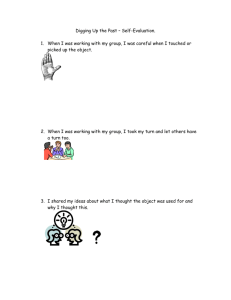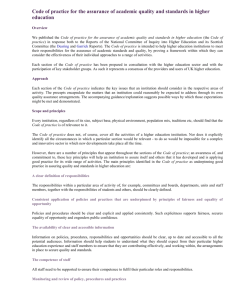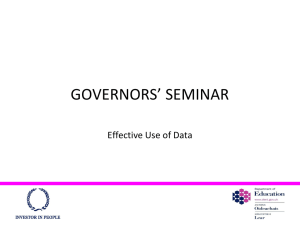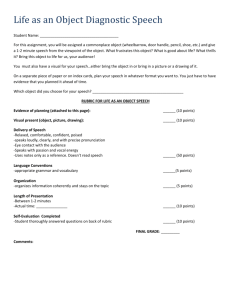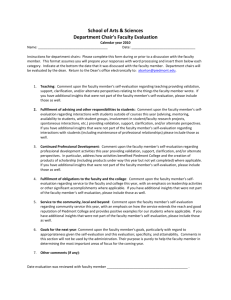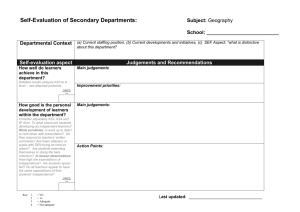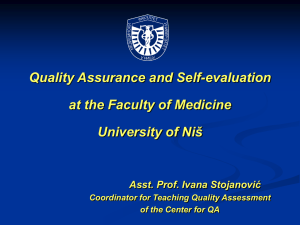Template for academic audit self evaluation
advertisement
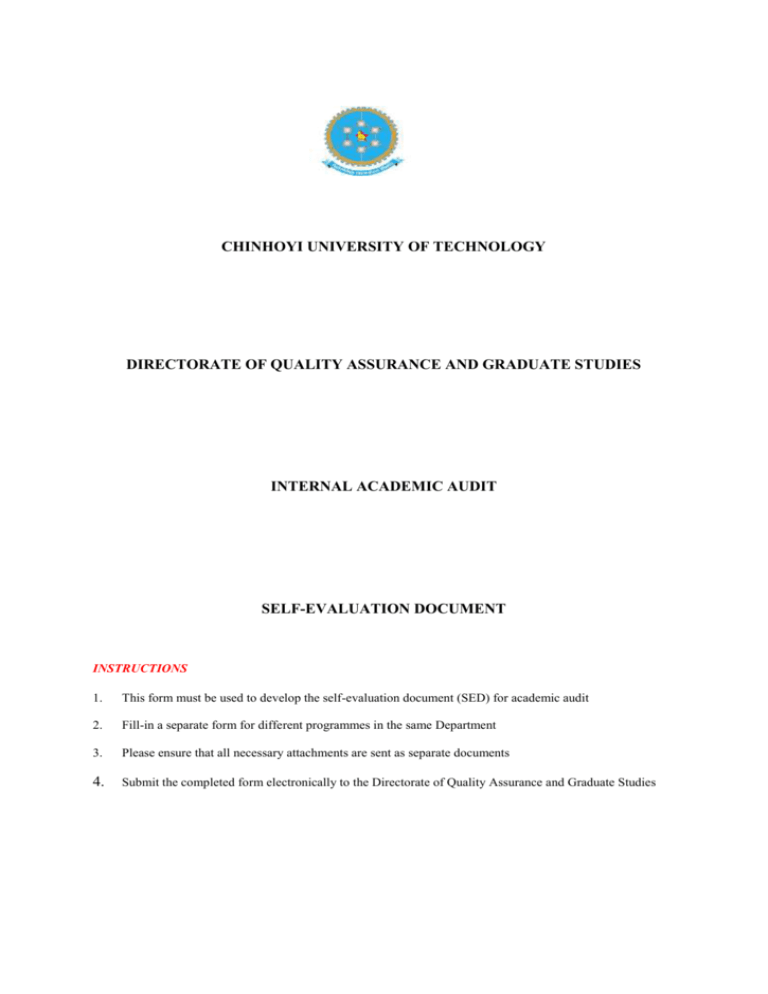
CHINHOYI UNIVERSITY OF TECHNOLOGY DIRECTORATE OF QUALITY ASSURANCE AND GRADUATE STUDIES INTERNAL ACADEMIC AUDIT SELF-EVALUATION DOCUMENT INSTRUCTIONS 1. This form must be used to develop the self-evaluation document (SED) for academic audit 2. Fill-in a separate form for different programmes in the same Department 3. Please ensure that all necessary attachments are sent as separate documents 4. Submit the completed form electronically to the Directorate of Quality Assurance and Graduate Studies DEPARTMENT DETAILS Name of Department: Name of Programme: Date of Submission of SED: Chairperson’s Signature: Dean’s Signature: AUDIT QUESTIONS The auditors will generally be guided by the questions given in each section in carrying out the academic audit of Departments. These questions guide the formulation of the Self-Evaluation Document (SED). DEFINING INTENDED LEARNING OUTCOMES (a) Define education quality in terms of learning outcomes State the intended learning outcomes of the programme. Delineate the outcomes into two categories – generic and professional, in line with the University mission. How do the learning outcomes relate to external reference points, e.g., relevant discipline benchmarks, requirements of employers and professional bodies? How do you ensure that the learning outcomes meet future employment needs of students and assist them acquire meaningful values and social skills? How are the learning outcomes communicated to staff, students, and external examiners? (b) Base decisions on facts Do you seek external input in the formulation of the learning outcomes? If yes, how do you do it? For example, do you use surveys or focus group interviews with employers and alumni? SELF-EVALUATION DOCUMENT Page 1 Are data from such surveys analysed so that you can establish a priori case? Explain (c) Identify and learn from best practice Do you evaluate learning outcomes of cognate departments in other institutions? Briefly explain. DESIGNING PROGRAMME CURRICULUM (a) Define education quality in terms of curriculum How does the Department ensure that the curriculum content enables students to achieve the ILOs? How does the Department ensure that the design and organisation of the curriculum is effective in promoting student learning and achievement of ILOs? Is there any evidence that the curriculum content and design is adequately informed by recent developments in pedagogy, research and changes in relevant occupational or professional requirements? State the evidence. (b) Co-curriculum development Who do you collaborate with in curriculum design? What have you learnt from former students and employers? How do you ensure that there is convergence or agreement on the essential elements of the curriculum? (c) Identify and learn from best practice Do you evaluate curricula of cognate departments in other institutions? SELF-EVALUATION DOCUMENT Page 2 (d) Make continuous improvement a priority How do you ensure that curriculum continuously remains up-to-date? What are the recent changes in your curriculum? What facts were used to make the decisions on curriculum changes? DESIGN TEACHING AND LEARNING PROCESSES (a) Design teaching and learning strategy How are your courses managed? Is there an appropriate and up-to-date teaching and learning strategy in the Department? How are teaching and learning organised for students? What pedagogical approaches are used? What strategies are used to stimulate student participation in the classroom and enhance student learning? What resources are used in teaching and learning? How is the quality of teaching maintained and enhanced? How do you ensure that strategies such as effective staff development, peer review, induction and mentoring are used? How effectively do lecturers draw upon their research, scholarship or professional activity to inform their teaching? Is there any academic support including handbooks and other written documents that is given to students? SELF-EVALUATION DOCUMENT Page 3 (b) Evaluating teaching and learning How does the Department review and calibrate its standards? What are your key performance indicators with regard to teaching and learning? How do you evaluate teaching and learning processes on a regular basis? How is it done? How are the data analysed and used for development? (c) Identify and learn from best practice Do you evaluate teaching and learning strategies used by cognate departments in other institutions? Explain DEVELOPING AND USING STUDENT ASSESSMENT (a) Define quality of assessment in terms of learning outcomes Have you defined key quality indicators of student performance based on the ILOs? State them. How do you ensure that the assessment processes overall and particular assessment instruments used enable students to demonstrate achievement of ILOs? How is assessment moderated? How do you ensure full confidence in the security and integrity of assessment procedures? Does the assessment have an adequate formative function in developing student abilities? How effectively is learning facilitated by formative and summative feedback and supervisory arrangements? How do you monitor student progress and use the information? SELF-EVALUATION DOCUMENT Page 4 (b) Base decisions on facts Are your assessment processes grounded in any conceptual framework? Can you defend your assessment measures by some appropriate theory, experience or empirical evidence? (c) Identify and learn from best practice Do you evaluate the teaching and learning strategies used by cognate departments in other institutions? IMPLEMENTING QUALITY EDUCATION (a) Design quality assurance mechanisms How are you organised to carry out your teaching and learning effectively? How do you assure stakeholders that content is delivered as intended and that teaching and learning processes are implemented consistently? How do you ensure that assessments are performed as planned and their results used effectively? (b) Work collaboratively to achieve inclusive involvement Do you collaborate effectively on the design of quality assurance methods? Do you work together to interpret the results and take appropriate actions based on quality assurance results? (c) Identify and learn from best practice Do you evaluate the quality assurance practices of cognate departments in other institutions? SELF-EVALUATION DOCUMENT Page 5 (d) Make continuous quality improvement a top priority Do you continuously and systematically evaluate your quality assurance mechanisms and align them with contemporary developments? SELF-EVALUATION DOCUMENT Page 6
